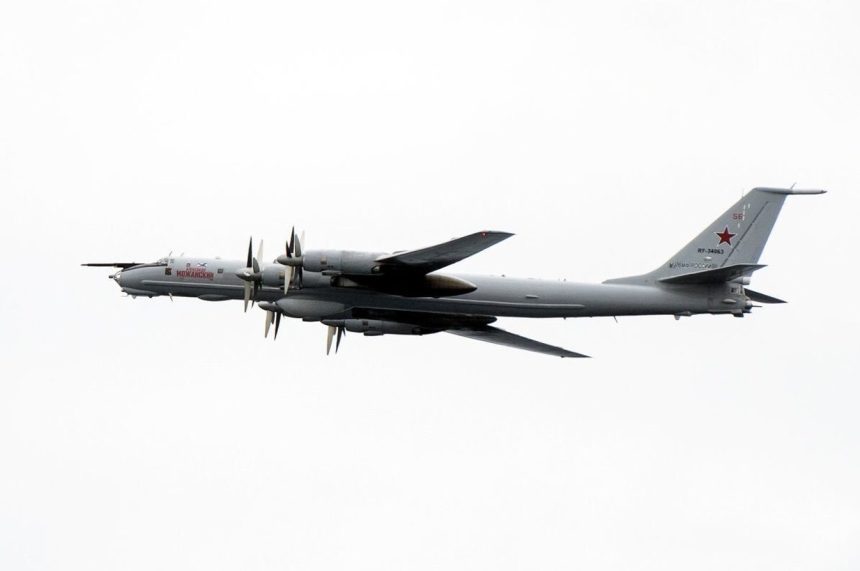A Russian Navy Tu-142 Bear-F long-range maritime patrol reconnaissance and anti-submarine warfare aircraft made a “surprise visit” to the USS Mount Whitney, off the Norwegian coast.
Sailors aboard the Blue Ridge-class command ship of the U.S. Navy USS Mount Whitney had gathered for a group photo on deck, when a Tupolev TU-142, RF-34063 / 56 RED based on AFP photographs, flying in international airspace, soared more or less overhead, on Nov. 2, 2018.
USS Mount Whitney is involved in Exercise Trident Juncture, NATO’s largest such drills in 20 years which runs through Nov. 7 and simulate an Art. 5 response to an armed attack against one ally. Needless to say, Russia has already made public its displeasure over the exercise that is considers an anti-Russian show of force. Consequently, Moscow announced plans to perform rocket test firings in the basin of the Norwegian Sea, from Nov. 1-3.
🔺 #NOTAM – Norwegian Sea:
🇷🇺 Russian Navy ‘ROCKET TEST FIRINGS’
“RECEIVED FROM MAIN AIR TRAFFIC MANAGEMENT CENTER OF RUSSIA
THIS IS TO INFORM YOU THAT The RUSSIAN NAVY PLAN TO ROCKET TEST FIRINGS IN THE BASIN OF THE NORWEGIAN SEA: 01, 02, 03 NOV 2018.
DAILY 0700-1400.” pic.twitter.com/hfENipSxDZ
— CivMilAir ✈ (@CivMilAir) October 30, 2018
Along with the missile tests in an area close to TJ exercise, on Oct. 31, Russia said two of its Tu-160 strategic bombers carried out a 10-hour routine mission over the Barents and Norwegian seas. NATO Secretary General Jens Stoltenberg said NATO drills would continue as planned. “I don’t expect that that will cause any serious problems, but as I said we will follow the movement of the Russian maritime capabilities closely, and they are informed about our exercise, so we do whatever we can to avoid any dangerous situation.”
Nothing dramatic then, if it wasn’t for the type of the Russian aircraft involved in the latest close encounter: a Tu-142MZ (based on the presence of the chin fairings) the last production variant of the “Bear F”, with new NK-12MP engines and a new avionics suite, a variant dubbed Bear-F Mod. 4 rarely spotted in that area. Last year we posted a video of a Tu-142MK filmed by a Royal Danish Air Force F-16. According to the RDAF the Russian Navy aircraft had only been seen in the area a few times earlier. In fact, the majority of the missions flown by the Russians over the Baltic Sea or around northern Europe involve long-range strategic bombers, such as the Tu-95 Bear and the Tu-22M Backfire.
According to “Russia’s Warplanes, Volume 2” by Piotr Butowski published by Harpia Publishing, one of the most authoritative sources on Russian-made military aircraft and helicopters today, the Russia’s Naval Aviation has two Tu-142 squadrons, one with Tu-142MK (NATO reporting name Bear-F Mod. 3) aircraft at Kipelovo-Fedotovo and one with Tu-142MZ (Bear-F Mod. 4) at Mongoktho.
The Tu-142MK and MZ are both able to carry a maximum of 9,000 kg (19,842lb) weapons load inside two fuselage weapons bays, with options including three torpedoes (the rocket-propelled APR-2/APR-3, or the electric AT-2M or UMGT-1) or depth charges (such as the Zagon/Zagon-2 guided charges and nuclear depth charges), mines and sonobuoys. The typical loadout of a Tu-142MK comprises 3x torpedoes and 66x RGB-75, 44x RGB-15, 10x RGB-25 and 15 RGB-55 sonobuoys.
By the way, the presence of the Russian Navy aircraft off Norway was the reason for the scramble of Royal Air Force QRA Typhoons from RAF Lossiemouth as well as Royal Norwegian Air Force F-16s from Bodo:
1755z: Y0H64 returning to Brize Norton pic.twitter.com/PFyHnS4EXX
— Mil Radar (@MIL_Radar) November 2, 2018
Top image: AFP photo/Jonathan Nackstrand









